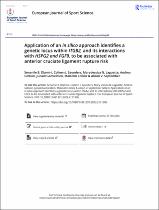| dc.contributor.author | Dlamini, Senanile B. | |
| dc.contributor.author | Saunders, Colleen J. | |
| dc.contributor.author | Laguette, Mary-Jessica N. | |
| dc.date.accessioned | 2023-06-13T12:58:08Z | |
| dc.date.available | 2023-06-13T12:58:08Z | |
| dc.date.issued | 2023 | |
| dc.identifier.citation | Dlamini, S. B. et al. (2023). Application of an in silico approach identifies a genetic locus within ITGB2, and its interactions with HSPG2 and FGF9, to be associated with anterior cruciate ligament rupture risk. European Journal of Sport Science, 23(6). https://doi.org/10.1080/17461391.2023.2171906 | en_US |
| dc.identifier.issn | 1536-7290 | |
| dc.identifier.uri | https://doi.org/10.1080/17461391.2023.2171906 | |
| dc.identifier.uri | http://hdl.handle.net/10566/9073 | |
| dc.description.abstract | We developed a Biomedical Knowledge Graph model that is phenotype and biological functionaware
through integrating knowledge from multiple domains in a Neo4j, graph database. All
known human genes were assessed through the model to identify potential new risk genes for
anterior cruciate ligament (ACL) ruptures and Achilles tendinopathy (AT). Genes were prioritised
and explored in a case–control study comparing participants with ACL ruptures (ACL-R),
including a sub-group with non-contact mechanism injuries (ACL-NON), to uninjured control
individuals (CON). After gene filtering, 3376 genes, including 411 genes identified through
previous whole exome sequencing, were found to be potentially linked to AT and ACL ruptures.
Four variants were prioritised: HSPG2:rs2291826A/G, HSPG2:rs2291827G/A, ITGB2:rs2230528C/T
and FGF9:rs2274296C/T. The rs2230528 CC genotype was over-represented in the CON group
compared to ACL-R (p < 0.001) and ACL-NON (p < 0.001) and the TT genotype and T allele were
over-represented in the ACL-R group and ACL-NON compared to CON (p < 0.001) group. | en_US |
| dc.language.iso | en | en_US |
| dc.publisher | Taylor and Francis Group | en_US |
| dc.subject | Bioinformatics | en_US |
| dc.subject | Semantic modelling | en_US |
| dc.subject | Biomedic | en_US |
| dc.subject | Biology | en_US |
| dc.title | Application of an in silico approach identifies a genetic locus within ITGB2, and its interactions with HSPG2 and FGF9, to be associated with anterior cruciate ligament rupture risk | en_US |
| dc.type | Article | en_US |

